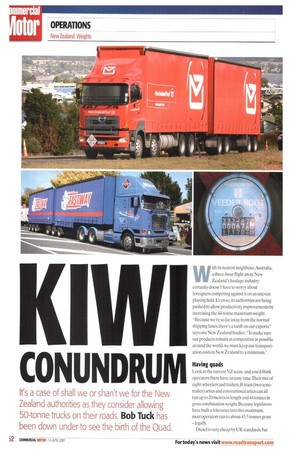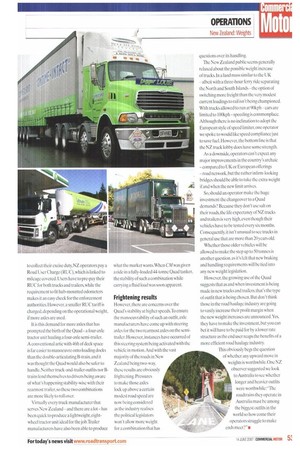CONUNDRUM
Page 52

Page 53

If you've noticed an error in this article please click here to report it so we can fix it.
It's a case of shall we or shan't we for the New Zealand authorities as they consider allowing 50-tonne truc.Ks on their roads. Bob Tuck has been down under to see the birth of the Quad.
With its nearest neighbour, Australia, a three-hour flight away, New Zealand's haulage industry certainly doesn't have to worry about foreigners competing against it on an uneven playing field. Even so, its authorities are being pushed to allow productivity improvements by increasing the 44-tonne maximum weight. "Because we're so far away from the normal shipping lanes, there's a tariff on our exports,says one New Zealand haulier. -To make sure our products remain as competitive as possible around the world, we must keep our transportation costs in New Zealand to a minimum."
Having quads Look at the current NZ scene and you'd think operators there have an easy time.Their mix of eight-wheelers and trailers, B-train (two semitrailer) artics and conventional artics can all run up to 20 metres in length and 44 tonnes in gross combination weight. Because legislators have built a tolerance into this maximum, most operators run to about 45.5 tonnes gross —legally.
Diesel is very cheap by UK standards, but to collect their excise duty, NZ operators pay a Road User Charge (RUC),which is linked to mileage covered. Users have to pre-pay their RUC for both trucks and trailers, while the requirement to fit hub-mounted odometers makes it an easy check for the enforcement authorities. However, a smaller RUC tariff is charged, depending on the operational weight, if more axles are used.
It is this demand for more axles that has prompted the birth of the Quad— a four-axle tractor unit hauling a four-axle semi-trailer. A conventional artic with 46ft of deck space is far easier to manoeuvre onto loading docks than the double-articulating B-train, and it was thought the Quad would also be safer to handle. Neither truck-and-trailer outfits nor Btrains lend themselves to drivers being aware of what's happening stability-wise with their rearmost trailer, so these two combinations are more likely to roll over.
Virtually every truck manufacturer that serves New Zealand — and there are a lot — has been quick to produce a lightweight, eightwheel tractor unit ideal for the job.Trailer manufacturers have also been able to produce what the market wan ts.When CM was given a ride in a fully-loaded 44-tonne Quad tanker. the stability of such a combination while carrying a fluid load was soon apparent.
Frightening results
11 owever, there are concerns over the Quad's stability at higher speeds.To ensure the manoeuvrability of such an outfit, axle manufacturers have come up with steering axles for the two rearmost axles on the semitrailer. However,instances have occurred of this steering system being activated with the vehicle in motion.And with the vast majority of the roads in New Zealand being two-way these results are obviously frightening. Pressures to make those axles lock up above a certain modest road speed are now being considered as the industry realises the political legislators won't allow more weight for a combination that has questions over its handling.
The New Zealand public seems generally relaxed about the possible weight increase of trucks. In a land mass similar to the UK albeit with a three-hour ferry ride separating the North and South Islands— the option of switching more freight than the very modest current loadings to rail isn't being championed. With trucks allowed to run at 90kph— cars are limited to 100kph —speeding is commonplace. Although there is no inclination to adopt the European style of speed limiter, one operator we spoke to would like speed compliance just to save fuel. However, the bottom line is that the NZ truck lobby does have some strength.
As a downside, operators can't expect any major improvements in the country's archaic — compared to UK or European offerings — road network, but the rather infirm-looking bridges should be able to take the extra weight if and when the new limit arrives.
So, should an operator make the huge investment the changeover to a Quad demands? Because they don't use salt on their roads, the life expectancy of NZ trucks and trailers is very high, even though their vehicles have to be tested every six months, Consequently it isn't unusual to see trucks in general use that are more than 20 years old.
Whether those older vehicles will be allowed to make the step up to 50 tonnes is another question, as it's felt that new braking and handling requirements will be tied into any new weight legislation.
However, the growing use of the Quad suggests that as and when investment is being made in new trucks and trailers. that's the type of outfit that is being chosen. But don't think those in the road haulage industry are going to vastly increase their profit margin when the new weight increases are announced. Yes, they have to make the investment, but you can bet it will have to be paid for by a lower rate structure as the end user reaps the benefits of a more efficient road haulage industry.
This obviously begs the question of whether any upward move in weights is worthwhile. One NZ observer suggested we look to Australia to see whether longer and heavier outfits were worthwhile:"The roadtrains they operate in , Australia must be among the biggest outfits in the world so how come their operators struggle to make ends meet?"•


























































































































































































